|
|
Post by martinm on Sept 9, 2019 6:50:17 GMT -8
I finally went on building a Batch Box Rocket Stove for a friend, here is the plan: The heat riser is on the side to allow for incorporating on the back a water heat exchanger for gravity fed hydronic heating of a second floor above. On the side of the first bell there will be an elevated bench"or something like a second bell. between the two bells in the middle there will be an ""inner chimney" which leads to a opening on the top of main bell to a real chimney. There are story and a half above the stove. All the walls of the stove will be build out of fire bricks and some are receiving outer shell of "clinker" type of well fired solid bricks or adobe layer , covered with lime. I have few issues haven't resolve and I keep reading here for references to similar situations/ details : 1. The height of the entry / opening to the bench/second bell so far I chose to make it is five brick layers or around 36 cm. Knowing that this will affect the performance of the system I wonder what will be better height? 2. The "Inner chimney" opens to the very low point of the second bell , faced out of the entry point of this bell. Hope this will create the effect of a open plan bench which a see here being build. My issue here is with the two sides of this inner solid stack of bricks , between the two bells - it will get a lot of heat from the first bell , which is good for securing draft , but perhaps I will loose too much heat ? should I put an insulation layer on the walls of this inner chimney faced to the heat riser ? How crucial is that ? I tend to think that I should put insulation there . Plan :  dry fit of the layout : 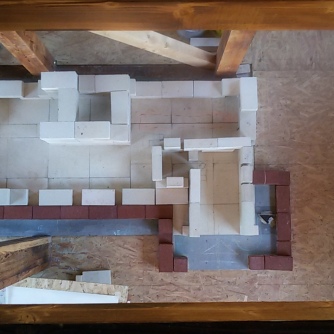 Schematic sections, explaining the relation between the two bells: 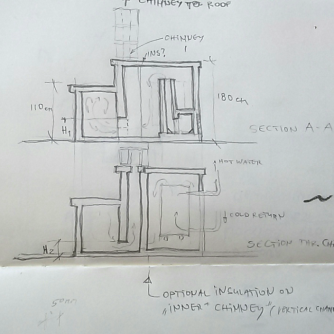 front view: 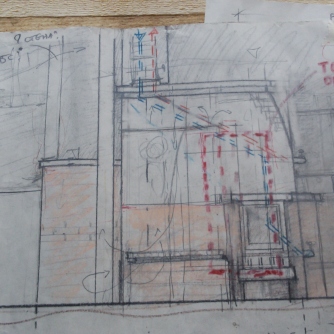 Greetings from the Balkans ! |
|
|
|
Post by gadget on Sept 9, 2019 18:08:35 GMT -8
Hey Martin,
It looks like its going to be a very nice heater once its all done. I can't answer your questions but I know other here should be able to give some insight.
I see your layout and was just wondering if you are planning on the brick being separated by the cement board that will just lay on the MDX wood subfloor? My concern would be heat making its way down to the sub flooring and also to the wood beams near by. I'm only assuming by looking at the photos - maybe you have other plans not shown. Also if its a multi story house there could be draft issues due to the stack affect. One other thing is all the weight on the floor joist. Just a couple of thoughts I had - you may have already addressed it but I just wanted to mention just incase. I would rather say something now while you're just getting started.
I'm looking forward to see how it progresses.
|
|
|
|
Post by martinm on Sept 9, 2019 21:28:37 GMT -8
I see your layout and was just wondering if you are planning on the brick being separated by the cement board that will just lay on the MDX wood subfloor? ... . Also if its a multi story house there could be draft issues due to the stack affect. One other thing is all the weight on the floor joist. Just a couple of thoughts I had - you may have already addressed it but I just wanted to mention just incase. I would rather say something now while you're just getting started. I'm looking forward to see how it progresses. Thank you for your input. Actually the whole stove sits on a separate concrete base - it was planned in such way with the owner. The level of the concrete base was lower so we had do lay down few concrete bricks and we put cement board on top to make it even. As for the draft - the two storeys are separate and there is a door betwween the staircase and the living room where the stove is located. |
|
|
|
Post by alarin on Sept 10, 2019 19:20:14 GMT -8
Здравствуй Мартин. Смотрел твой проект, но не все понял. Для чего второй колокол? Чтобы газ двигался мы отбираем сухое тепло в первом колоколе и устанавливаем теплообменник в его нижней части. В итоге газ может оказаться сильно холодным, чтобы удалятся дымовой трубой. У меня в колоколе температура газа доходит до 600 градусов Цельсия, а внизу после теплообменника не превышает 65 градусов. В таких условиях газы двигаются очень хорошо.
Hello Martin. I watched your project, but did not understand everything. What is the second bell for? In order for the gas to move, we select dry heat in the first bell and install a heat exchanger in its lower part. As a result, the gas can be very cold to be removed by the chimney.In my bell, the gas temperature reaches 600 degrees Celsius, and below after the heat exchanger it does not exceed 65 degrees. Under such conditions, gases move very well.
|
|
|
|
Post by peterberg on Sept 11, 2019 0:30:38 GMT -8
I have few issues haven't resolve and I keep reading here for references to similar situations/ details : 1. The height of the entry / opening to the bench/second bell so far I chose to make it is five brick layers or around 36 cm. Knowing that this will affect the performance of the system I wonder what will be better height? Best construction I've seen (and built) so far: the opening as large as the complete height and width as the bench. In effect, the bell and bench will combine at the level of the bench so gases will be moving much, much slower there. Good for heat extraction, even fine dust will settle at the floor because of that. Just think of the whole setup as one, irregular shaped bell. Normal internal surface area calculation method is valid this way. 2. The "Inner chimney" opens to the very low point of the second bell , faced out of the entry point of this bell. Hope this will create the effect of a open plan bench which a see here being build. My issue here is with the two sides of this inner solid stack of bricks , between the two bells - it will get a lot of heat from the first bell , which is good for securing draft , but perhaps I will loose too much heat ? should I put an insulation layer on the walls of this inner chimney faced to the heat riser ? How crucial is that? I tend to think that I should put insulation there. Insulation on the surface of an internal chimney can be done, but you will loose mass and ISA this way so you need to compensate for that. Personally, I wouldn't do that but oversizing the bell slightly and installing a bypass is better in my opinion. When calculated correctly it can be built without a bypass and working very well at the same time, though. The bench open to the bell opens the ability of having the chimney entrance anywhere on the perimeter, so there's much more freedom where to place the chimney stack itself. |
|
|
|
Post by martinm on Oct 4, 2019 20:02:10 GMT -8
...What is the second bell for? In order for the gas to move, we select dry heat in the first bell and install a heat exchanger in its lower part. As a result, the gas can be very cold to be removed by the chimney.In my bell, the gas temperature reaches 600 degrees Celsius, and below after the heat exchanger it does not exceed 65 degrees. Under such conditions, gases move very well. The lower part of the stove (second bell) was designed because of the specifics of teh interior - low wood construction element , proximity of kitchen countertop on this side etc. second thought was the intention to slow down the movement of gases in the first and by doing so allow for more heat to be extracted from the water heat exchanger. Thank you for sharing your experience . I kept building the inner refractory brick walls and considering your and peterberg advice I didnt build the low arch separating the two "bells"(колпак?)р However after a consutation with an experienced piping water heating craftsman I am re-considering building a partial separation in the higher part of this wall between the low and high part. The main reason is to concentrate the heat in the higher part of the bell (first bell). Beacause of concerns about the quantity of heat which will be pumped to the water heating system for the second floor we oversized the heat exchanger - now we calculate it as 7 pipes 2" each H=120cm connected at low and high level with square tube 10 cm . PLus tehre will be extensions on every tube sideways ... total volume of water= 4.2 ltr. Outer surface 4 m2 . There will be a insulated hot water buffer container at above second floor to compensate for the fluctuations . We are considering 300 ltr or perhaps 500 ltr ... ? alarin - from your experience - how long after the fire is gone , the water heat exchanger keeps pumping hot water for radiator heating ? and my second worry is that oversized heat exchanger will take longer time for the water to start turning into hot water. It is for first time in my life dealing with such complex stove ... but my intuition is that the more water contains teh system , the better will performm in regards with te specifics of teh firings of massive masonry stove - a lot of heat for few hours and then just accumulated heat , so teh water will heat extensively for few hours and afterwards the heat from the surrounding walls will radiate and provide few more hours for the hot water to be usable for heating the socond floor ... will see . Further down I will put an update to where I am now in this project. PS : Извините меня но мой руский не очен хорош . Здес мого лудей оворят английский поетому я пишу на английский. Спасибо за ответа друг ! |
|
|
|
Post by martinm on Oct 4, 2019 20:08:01 GMT -8
Best construction I've seen (and built) so far: the opening as large as the complete height and width as the bench. In effect, the bell and bench will combine at the level of the bench so gases will be moving much, much slower there. Good for heat extraction, ... Thank you peterberg < I do undesstand the concept of keeping the fluids "calm" and slow in the bell, however I tend to lower the wall between the two parts - with the intent to keep the higher part with stratified hot gasess to lower part - beacause we want also to extract some heat with teh water heat exchanger. I will post an update further in the tread > |
|
|
|
Post by martinm on Oct 4, 2019 21:16:39 GMT -8
Here is update on the 20cm batch box masonry heater with hot water heat exchanger: Batch box completed - it is with the size for a 20cm system on top it will be covered with two layers of volcanic stone plates each 3cm thick . In front I am considering the extended part of the batch box from the main body of the stove to be covered with Ca silicat insulation and then covered with another 3cm stone plate. The stove as for today : 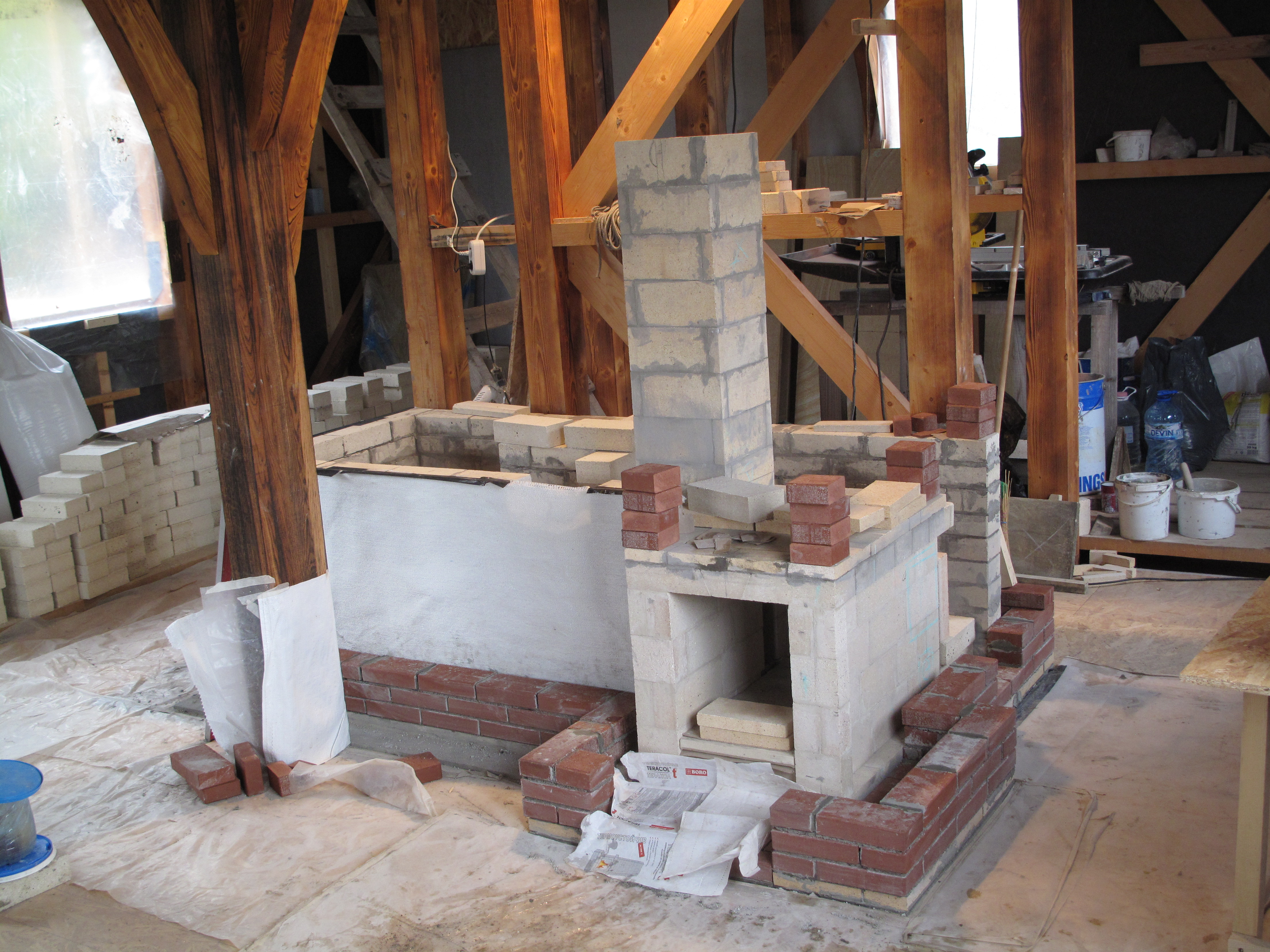 We ordered the heat exchanger for water heating for the upper level : here the issues are with the amount of heat and the dynamics of the firings ... we did some consultations with hydronic heat specialists and we end to the conclusion that the heat exchanger should be over sized - with more water in it and more exchange surface. I hope that after the fire is dead there will be enough heat to keep the water moving with considerable temperature for few more hours. Heat exchanger size and layout :  I am still thinking about lowering the separation wall between the two parts of the stove - in a way to make a two bell system . I want the heat to stay for a while around the heat exchanger ... 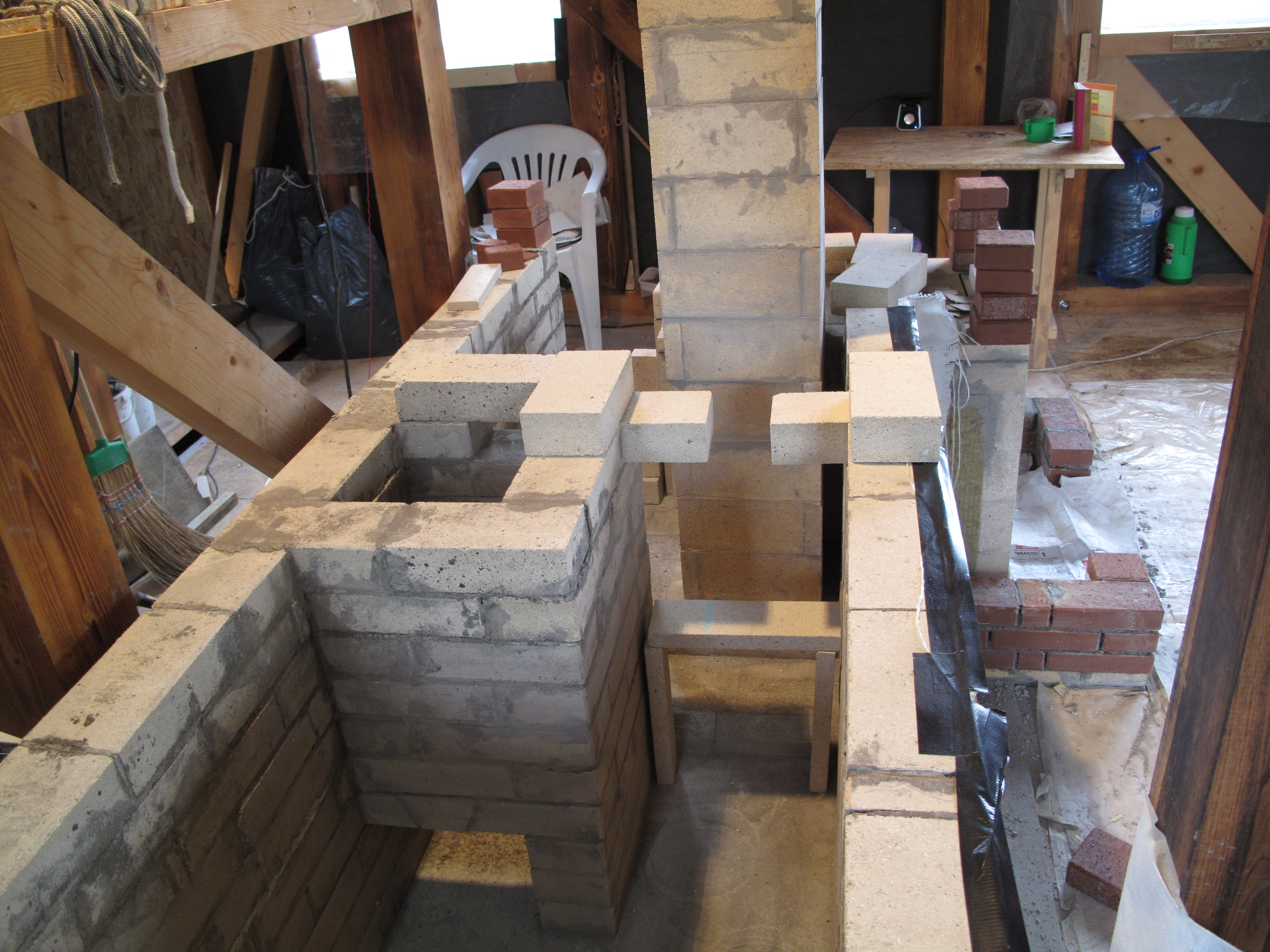 Position of heat exchanger ": 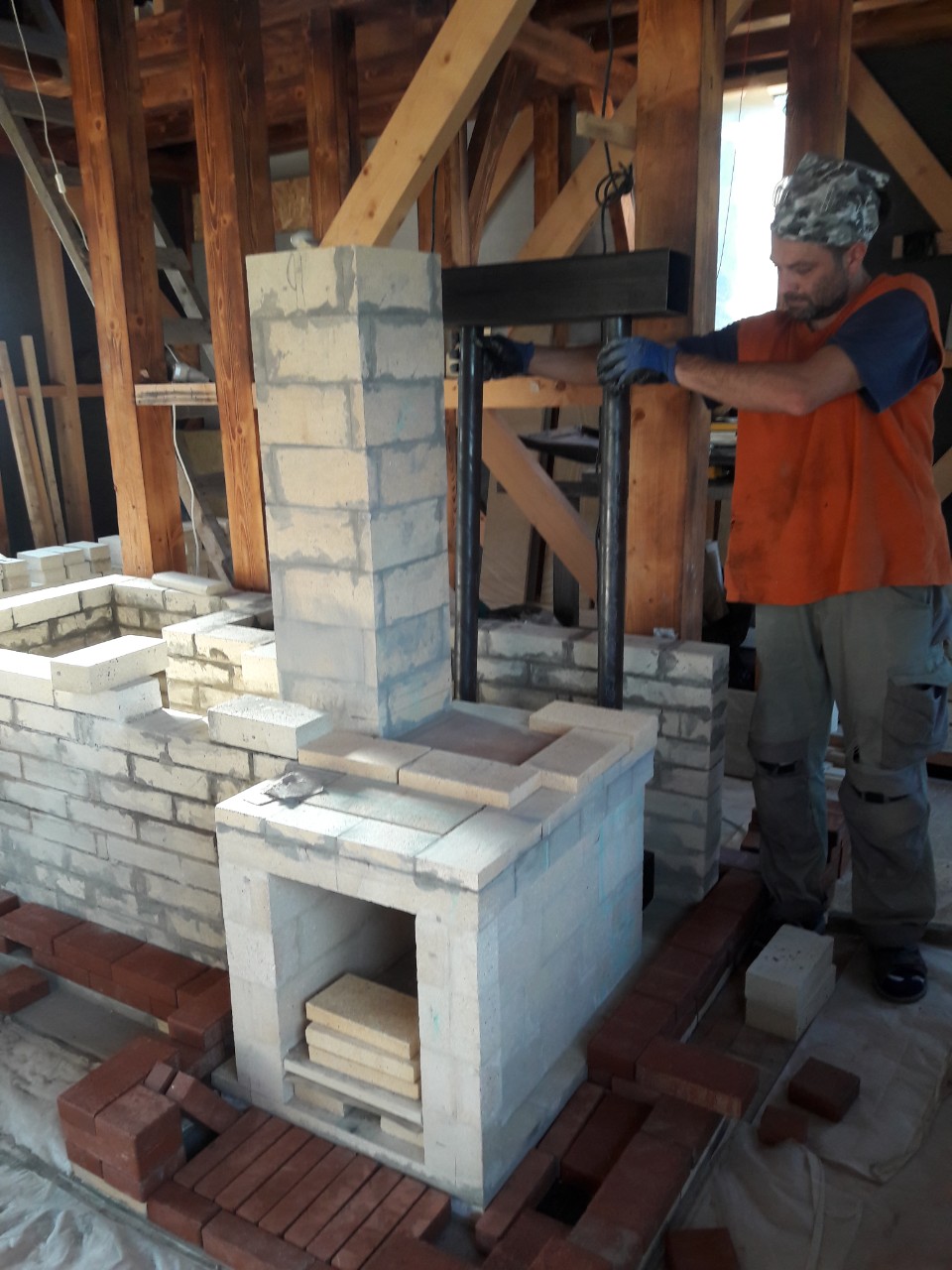 The wall , opposite to the batch fire box will be partially insulated from the outside - because there is a staircase behind this wall , thee is wood structure next to the bricks and in this part inside there will be the water heat exchanger - the intention is the heat to "stay " there longer. In regards wiith this heat exchanger : I left the refractory wall with a vertical "gap" on the side of the heat excchanger - for easy instalation and eventual repairs. Unfortunately this decision lead to another issue - long part of the back wall will stay as a staight wall , disconnected from the perpendicular other walll. I put few brackets in between the firebricks and screw the ther end to the wood post behind. I also put ceramic wool ther for some added insulation . Hopefully the bracket will not heat up so much to set the wood on fire... 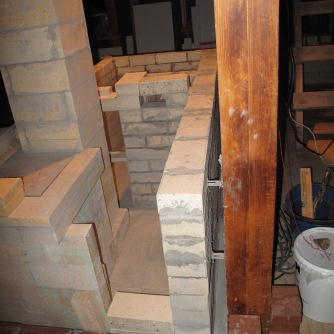 in The lower part of the stove the refractory core will be surrounded by "klinker " type face bricks. Up from the level of the face bricks we are planning on adding ~5-6 cm thick layer of cob. Peace and Prosperity ! |
|
|
|
Post by gadget on Oct 4, 2019 21:52:40 GMT -8
Impressive building skills you have there. I'm interested to here how the water heating works out.
|
|
|
|
Post by esbjornaneer on Oct 26, 2019 6:30:15 GMT -8
I'm also looking forward to hearing how this build progresses and works when completed!
I hear what you are saying about the wall between the 1st and 2nd bells... am I right that the heat exchange unit reaches below the top of the 2nd bell? If that is the case it makes sense what you are saying about adding the wall. But remember that you should have 15% less total ISA in a 2-bell setup than a single bell like Peter is suggesting, and you are getting extra ISA from the dividing wall.
I strongly second the suggestion to have a by-pass valve/damper to make sure you get the chimney going unless you have done the calculations carefully about the total ISA and taken into account potential difference in heat extracting behaviour between a bell and the heat exchanger. (Please enlighten me if there is no difference.) From experience I can tell you there is nothing as dishartening as building it all and not get the chimney to draw enough.
Best wishes, Esbjorn
|
|
|
|
Post by martinm on Nov 6, 2019 23:26:18 GMT -8
Here is an update on the stove build> Between the lower part (second bell) and the main bell I did build an archway at lower point , because the heat exchanger is 140 cm high and quite huge (external surface 3,8 m2 ) By adding this water heat exchanger the ISA is more than the suggested by the batchbox site creators. I did that because there was a consideration that the stove would burn longer than usual rocket stove with such size - to provide heat to the heat exchanger and further to supply hot water to the insulated buffer wessel on the upper floor (500 liters). While building it I also added a small oven in front of the internal chimney and with valve opening next to and bellow the "cold start valve" . The stove is still wet so I put a hot air blower every night in front of the fire box to turn the air inside. We did put a small fire to test if there is draft . with the cold start valve open the fire goes through the port with no hesitation ! The top of the main bell is covered with 5cm aluminum silicate insulation which compensates for the ISA over-sizing . I think that by adding insulation on top will provide more heat for the water heat exchanger. Will see- we need to carefully condition it with the hot air blower and then few samll fires before the real test .  Thank you all for the interest and comments . |
|
|
|
Post by gadget on Nov 7, 2019 7:26:30 GMT -8
Looks amazing! What a great looking heater.
Are you going to make the water heater closed system so as to keep the rusting down? I'm looking forward to seeing this thing going.
|
|
|
|
Post by martinm on Nov 7, 2019 20:45:27 GMT -8
First firing of this heating structure. smaĺl fires will burn for few days to aĺow for dtying. It starts with the cold start valve open and ten minutse later the gasses could turn into the the full path . youtu.be/-wBz-MKNAWk |
|
|
|
Post by Jura on Nov 8, 2019 3:02:57 GMT -8
Marvelous built.
I wonder If that floor plate above the floor channel is necessary as It only stands for a thermal barier to preheating the air in the channel.
|
|
|
|
Post by martinm on Sept 4, 2024 8:19:29 GMT -8
This is the almost finished stove. it is operational for 5 years. Works well and heats both floorrs of the house. The water heat exchanging system is a little bit innert and it doesnt provide enough heat for the few radiators upstairs and because of this there is tendency for overheating the lower floor where the radiant heat of the stove is getting excesssive when trying to heat the hot water system.  |
|
















